
What is Shopify? A Beginners Guide to Starting Their Ecommerce Journey

- What is Shopify?
- So What Does Shopify Do?
- What Are the Advantages of Shopify?
- What Can I Sell on Shopify?
- Why Do People Shop Online?
- How Do I Get Started with Shopify?
- How much does it cost?
- How Can I pay?
- How Do My Customers Pay?
- Shipping with Shopify
- Which Countries/Languages Does Shopify Support?
- How Do I Design My Store?
- What Resources are Available to Me with Shopify?
Convenience. Variety. Competitive pricing. Promotions. Trends. Niche products. These are just a few of the buzzwords you will hear jump out when discussing the enormous global ecommerce industry.
Nowadays, it’s vital for businesses to connect with consumers in the virtual market or risk being left behind and forgotten.
But what about business owners that aren’t web dev or marketing gurus?
Rest assured, Shopify exists to help you migrate your business to the web, design and market your brand, and start making sales in no time.
What is Shopify?
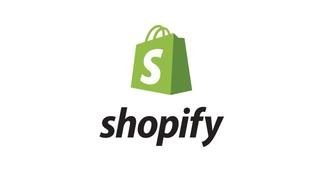
Shopify was launched in 2006 by Tobias Lutke, a Canadian computer programmer, in response to a failed snowboarding equipment business that he had attempted to start online. He was dissatisfied with the ecommerce solutions available at the time, so took it upon himself to create one of his own. The result was Shopify, one of today’s most powerful and pervasive ecommerce platforms.
With over 600,000 merchants at present, Shopify’s user-friendly interface is an ideal solution for both niche markets and larger retailers. This makes it very attractive to business owners that may just be starting out with launching an online store.
So What Does Shopify Do?
With a projected 17.5% of all global retail sales being done online by 2021, it’s easy to see why retailers need systems that enable them to market, sell, and distribute their products directly from a website. This form of online trade is colloquially known as “ecommerce”.
Shopify equips new and existing sellers with the tools and resources to design and create their own online store. The biggest selling point is the fact that it simplifies the process for entrepreneurs that might lack certain technical aptitudes needed for web development.
To answer the question “What is Shopify?” is not a quick and easy thing to do as there is significant depth to many of the features and resources available.
But fear not.
In this article we will provide a comprehensive examination of what Shopify has to offer your business and how it works.

What Are the Advantages of Shopify?
Electronic commerce presents a large number of advantages versus traditional brick and mortar retail stores. To name a few:
- Exposure to larger markets: having a presence online means that anyone can access your store and purchase your products from anywhere in the world.
- Unique marketing techniques: Shopify offers extensive training to new business owners through resources like their free Ecommerce University. This and other Shopify support systems are in place to teach you how to execute an effective online marketing strategy, but more on this later.
- Low overhead: an online store does not necessarily require large expenses like rent, tangible materials, or a large team of employees. It is much easier to control your expenses depending on the scale of your business.
- 24/7 selling opportunity: this is self-explanatory. The internet is never closed for business!
- Suitable for niche markets: while traditional retail outlets take a huge risk when their products are targeted at a relatively small group of consumers, with Shopify it is easy to generate a brand image that is appealing to your target market.
These, among other factors, can contribute to enormous growth potential when executed correctly. Shopify offers the resources necessary for any entrepreneur to access the billions–yes, billions–of potential customers that shop online in the modern digital age.
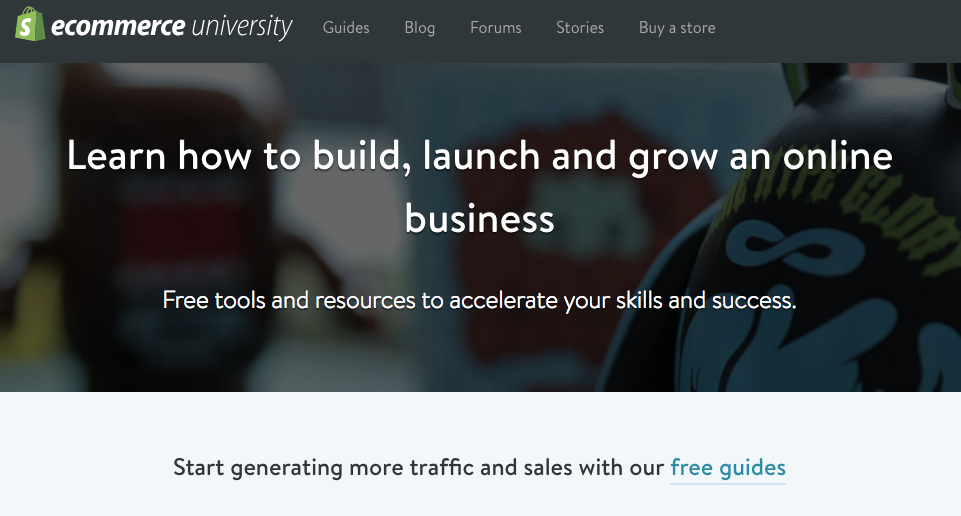
Earlier this year, Shopify expanded across the globe, creating ever larger opportunities for online retailers to seamlessly take their business international.
What Can I Sell on Shopify?
The range of products that can be sold on the Shopify platform is seemingly limitless. Mainstream products are certainly not the only contenders for profitability when it comes to ecommerce.
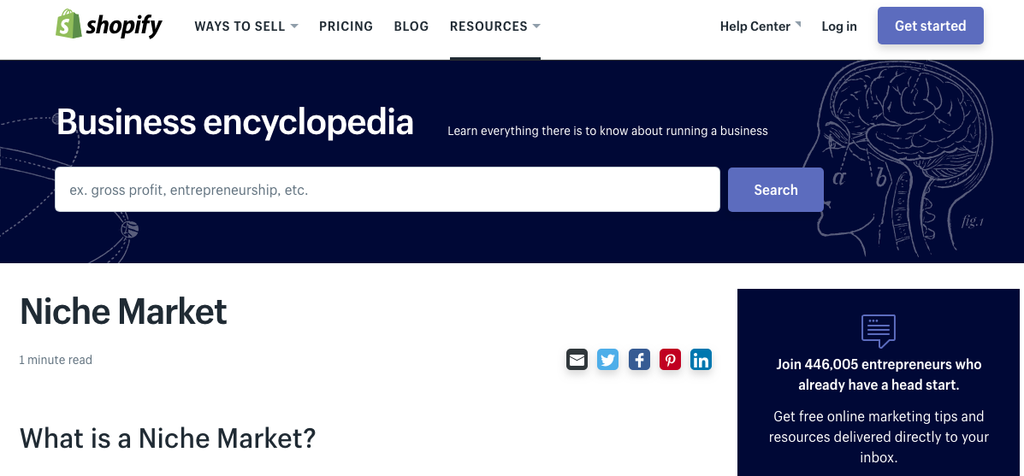
Shopify is home to businesses from all across the spectrum; you don’t need to be a high-volume store or have something completely proprietary to be successful. This is the beauty and power of having the ability to create something modern, stylish, powerful and effective to help your business grow.
Some of the top industries for ecommerce platforms include fashion, electronics, furniture, and health & beauty amongst many more. There are outstanding design tools available as “themes” to help users make sure their site is attractive to their target market. We will go into more detail on themes later in this article.
Oh, and as previously stated, a business does not need to operate within these industries to be successful–not by a long shot.
If you’re interested, here are some examples of products that are on-trend and profitable despite not being something that every consumer is necessarily looking to purchase.

But what if I don’t sell tangible goods?
Shopify merchants are not restricted to selling physical items either. With some customization, a Shopify store can be tailored to market and sell services, digital products, memberships, and many more. Here is a list of examples of stores that have been very successful using the Shopify platform to sell a variety of products and services.
Why Do People Shop Online?
This is a difficult question to answer specifically because there are millions of reasons individuals utilize the internet to fulfill their purchasing desires. It’s important to identify some core reasons why people shop online to better understand how to create value for your customers:
- Comparison: traditionally you might see a few different makes of a product in a conventional retail store, but your choices were limited to what brands were carried. Now people can compare any product with options from all over the world.
- Variety: similar to the point above, you can now find wide ranges of different items from different producers, especially in niche markets. One of the most valuable parts of ecommerce is being able to locate and purchase niche items that are not available in typical stores.
- Prices: thousands of deals and promotions are available daily and the internet allows you to seek out those bargains from the comfort of your home. Purchasing from an online store will often remove any aggregate pricing resulting from incurred distribution and shipping costs as well.
- Reviews: consumers now have millions of reviews from discerning shoppers to aid in their decision on a specific product.
- Convenience: shopping from home saves times and energy by preventing unnecessary and often unsuccessful trips to a store.
How Do I Get Started with Shopify?
Firstly, all you need to get started is a computer with internet access and an email.
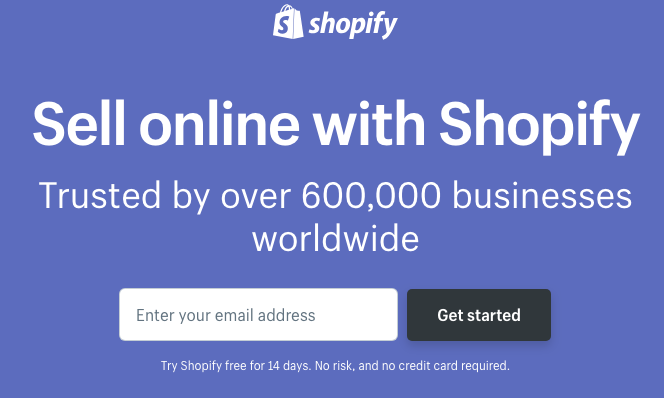
Shopify offers a great 14-day free trial to allow prospective ecommerce merchants to test all of the available features without any need to input credit card or payment details.
For a complete guide on how to register and start building your store, visit our Shopify registration tutorial blog.
Once you’re convinced of what Shopify will do to enhance your business, there are several plans available to suit the size and goals of your store. After reading this article, you’ll have all the knowledge you need to get started.
Or if you’re a more ‘hands-on’ type of person, go ahead and start building your store now.
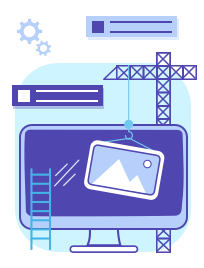
How Much Does It Cost?
Shopify plans vary from $9-$299 monthly, with the ultra-premium Shopify Plus, which is designed for extremely high volume stores, at $2000. As you ascend into more premium service, the benefits increase accordingly.

Here’s a brief breakdown of each plan and the privileges/fees that are included.
- Lite Plan – $9 per month + a Buy button
- Basic Shopify Plan – $29 per month + 2.9% and 30¢ per transaction
- Shopify Plan– $79 per month + 2.6% and 30¢ per transaction
- Advanced Shopify Plan – $299 per month + 2.4% and 30¢ per transaction
- Shopify Plus – pricing plans start around $2000 per month + 1,6% and 30¢ per transaction
Note: Shopify Buy Button lets merchants generate an embeddable product card and checkout that can be placed on any type of website
For more information about what considerations to make before deciding which plan is right for you, read through our blog post specifically regarding pricing and benefits.
Shopify will also allow you to purchase an affordable domain name for your site. The prices for these will also vary depending on how desirable or specific they are to certain industries. If you choose to pass on registering a paid domain name, your stores URL will default to storename.myshopify.com.

How Can I pay?
Users need a Visa, MasterCard or American Express to pay for their ecommerce site.
Detailed invoices are issued via email every 30 days, but users can also opt to pay for an annual plan. These invoices will include a summary of all fees from that billing period.
Be aware: cards are charged automatically so the card owner is responsible for notifying Shopify if they have processed any transactions for test purposes or other circumstances that would not warrant a real fee.
How Do My Customers Pay?
Shopify Payment is currently available in the following countries:
- United States (Not US territories except Puerto Rico)
- Canada
- United Kingdom
- Australia
- Ireland
- New Zealand
- Singapore
The most common form of transaction will be completed via credit card, and payment support for all major credit cards is included with all Shopify plans. There are other options as well as Shopify can accommodate many different forms of payment. By contacting Shopify Support, users can get assistance in setting up the necessary processes to accept orders through different payment gateways.

Third-party payment gateways will allow you to accept payments from many different regions using many different types of currency.
Money from purchases will be deposited into your ‘merchant account’ after it has been processed and approved by Shopify.
Shipping with Shopify
For most smaller stores, the owner will opt to take care of this aspect of their business themselves. Provided their customer base is moderate enough that they can keep up with demand, this is a good way to keep costs lean and even an opportunity to offer a higher quality customer experience which can be especially important in niche markets.However, if a business grows rapidly, the owner may find that they simply cannot facilitate the delivery of all orders efficiently.
This is when to look into using a third-party fulfillment service. ShipStation is a fabulous option and is partnered with nearly every major ecommerce platform.
There are apps available that are connected to major shipping companies as well. Visit the app store to see which apps will be most helpful. Remember to check the reviews and testimonials!

Some options for these services are included in the Shipping Settings of a Shopify account by default. These are trusted companies that offer assistance to many other stores, and owners are welcome to seek out alternative solutions of their own.
Which Countries/Languages Does Shopify Support?
Your Shopify admin is currently available in English, French, German and Japanese. First take a look at this Shopify blog post to get an in-depth explanation.
That being said,
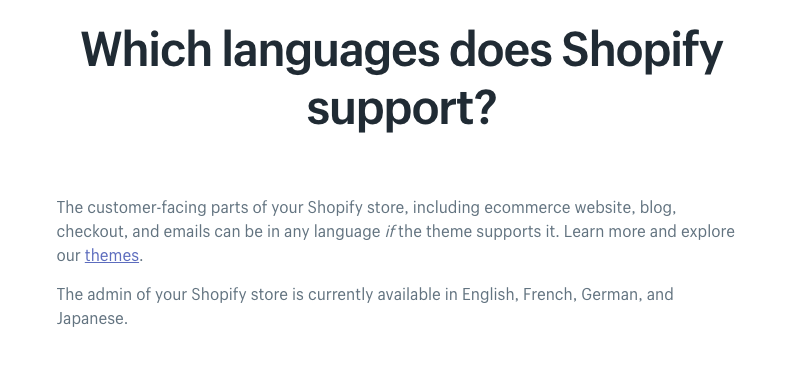
“The customer-facing parts of your Shopify store, including ecommerce website, blog, checkout, and emails can be in any language if the theme supports it.” [Shopify.com, 2018]
This means that provided your store uses a theme that supports the language of the market you are targeting, your customers will be able to browse without difficulty in their native tongue.
Apps like Langify can be extremely helpful in making your store accessible to users in multiple languages.
How Do I Design My Store?
There are two main options for organizing and adding aesthetic value to your Shopify store:
Shopify has an experts directory from where merchants can hire professionals to aid in the construction of their store. There are also third-party services like StoreTasker that may offer similar services at a competitive price or with distinct strengths outside of the Shopify ecosystem.
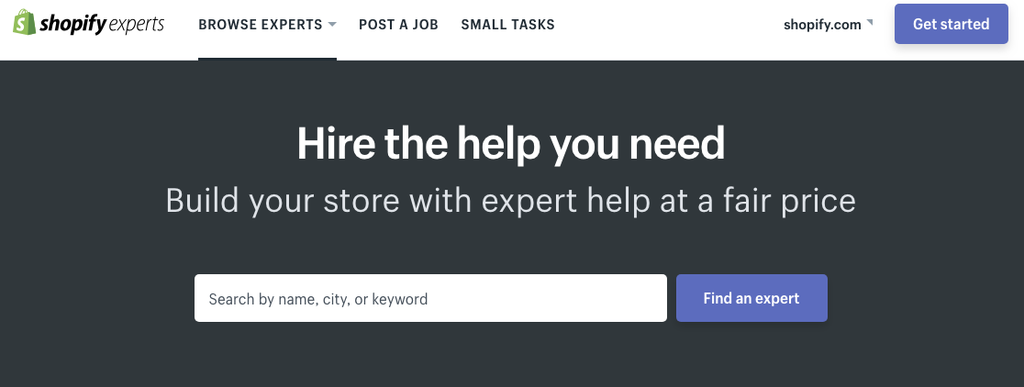
The second and likely more suitable option for start-up stores is to use a theme. Themes are templates that allow the merchant to manage the design, layout and content of their site through an intuitive interface and without the requirement of coding skills.
Themes range in price from free to around $200 and can usually be demoed for free from the Shopify theme store. As with many other aspects of Shopify, there are native themes and themes created by third-party developers. A popular site to browse for these is at ThemeForest.

The Shopify theme store
For more information about themes and how to use them, check out our Shopify themes overview and Brooklyn Shopify theme review articles.
The majority is Shopify merchants also rely on apps to improve the design and functionality of their store. These apps are available as free, paid, and subscription-based options to enhance your site. The new Shopify App store has an enormous collection of applications for many different categories and uses.
Apps like PageFly page builder can help you take the style and control of your store even further. You can view PageFly and thousands of other applications at the Shopify App Store.

What Resources are Available to Me with Shopify?
Shopify has a huge library of information and resources available to help ensure your ecommerce success. To name a few:
- Shopify Help Center
- Shopify Support
- Shopify Forum
- Shopify Experts
- Shop Class
- Shopify Business Encyclopedia
- Shopify Academy
These resources (aside from hiring an expert) are available to merchants for free to supplement their existing plan. With access to this incredible volume of proven information from real experts and other merchants is priceless for individuals who are new to ecommerce.

For a complete summary of all the support and resources available, read our Shopify support blog.
Now that you are equipped with the knowledge you need, it’s time to jump in and start your ecommerce journey today. Start with the 14-day free trial and a free theme from the Shopify theme store to try the incredible tools and features that are available to you.
If you feel that you’d like some more information on the topics discussed in this article, visit our helpful series of blogs regarding all things Shopify:
- Shopify Help, Support & Resources
- Shopify Plans & Pricing
- Shopify Themes Overview
- Shopify Theme Review and Tutorial
- Shopify Registration Tutorial
Finally, for any lingering questions that weren’t addressed, leave a comment below and we will provide a solution for you!
As always, share any stories you have about your experience with Shopify as well.
Happy selling, bonne chance!


